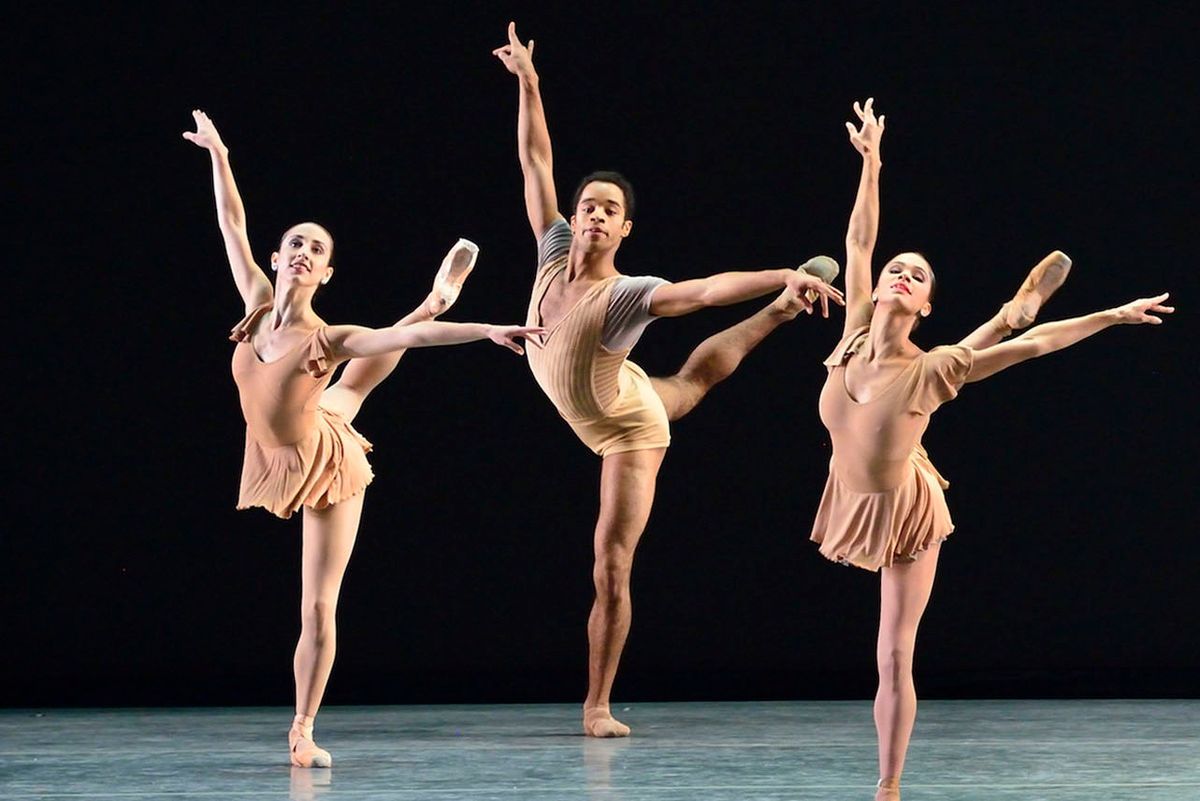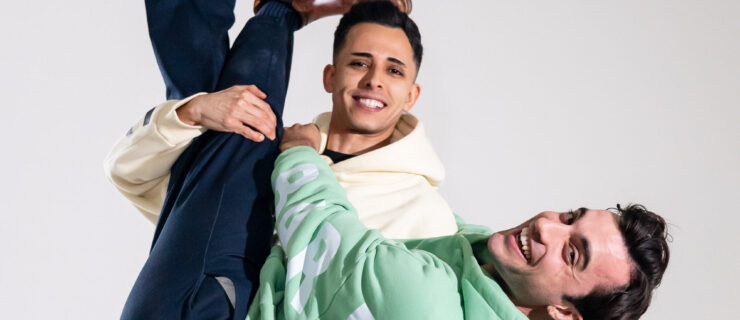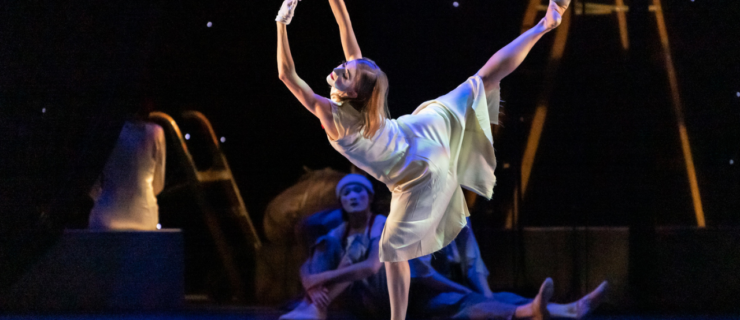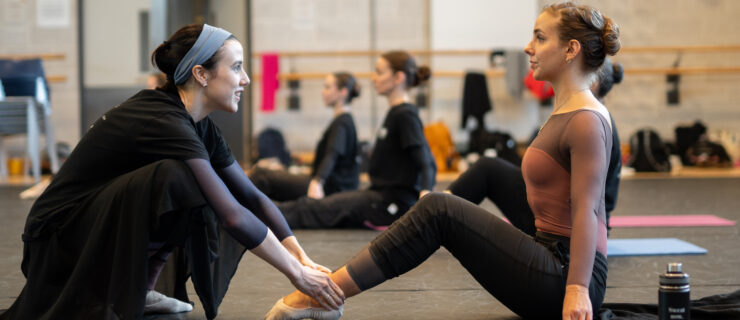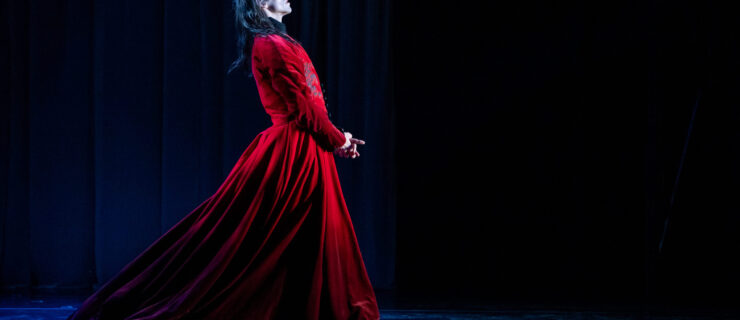2015 Stars of the Corps: 10 Dancers Set to Ascend the Ranks
This story originally appeared in the August/September 2015 issue of
Pointe.
Here are 10 corps de ballet dancers to keep an eye on.
Elizabeth Wallace, Pennsylvania Ballet

Wallace in Nutcracker. Photo by Alexander Iziliaev, Courtesy Pennsylvania Ballet
At 5′ 9″, Elizabeth Wallace naturally stands out in a group. But in addition to stem-like limbs, it’s her generous upper body, lissome extensions and easy command that draw the eye. In Pennsylvania Ballet’s Swan Lake last March, she delivered a natural authority, her movements grand and sweeping in both the Act I court ensemble and as a Big Swan in Act II.
Born in Kentucky, Wallace, 23, trained at Lexington Ballet, Kentucky Ballet Theatre and Bluegrass Youth Ballet before attending the School of American Ballet on scholarship. An apprenticeship with New York City Ballet followed before joining PA Ballet in 2012. “It’s a smaller company, but I was understudying principal roles right off the bat,” says Wallace. “That wouldn’t have happened at City Ballet.” She received her first major opportunity last fall, when artistic director Angel Corella cast her in Christopher Wheeldon’s Liturgy. “I had never done a principal pas de deux before,” she says, noting that the experience has been the highlight of her career so far.
Wallace admits that her height can make casting an issue. “You can’t put me in any old corps spot, and it’s hard finding a partner,” she says. “But when I do get the chance, the roles tend to be pretty great.” Case in point: She’s learning Queen of the Dryads for Corella’s 2016 production of Don Quixote. —Amy Brandt
Gabe Stone Shayer, American Ballet Theatre

Shayer in ABT’s Don Quixote. Photo by Martha Swope, Courtesy ABT.
American Ballet Theatre’s Gabe Stone Shayer is full of surprises. “I think because of my body type and my ethnicity people expect me to move a certain way, but with my training background, I tend to look more like a Russian dancer,” says Pennsylvania-born Shayer, who joined the company in 2012 after studying at The Rock School for Dance Education and then the Bolshoi Ballet Academy in Moscow.
Shayer attributes his perfectionist work ethic and striking movement quality to his Russian training. Though his dancing is impeccably clear, he’s not lacking in versatility and charm—in fact, these very qualities have made him a favorite of ABT artist in residence Alexei Ratmansky. Several of Shayer’s standout roles have been in Ratmansky pieces, including a principal role in Shostakovich Trilogy and the sprightly Ariel in The Tempest. But he’s a classicist at heart, dreaming of someday performing dramatic roles like Romeo, Des Grieux and Onegin, and appearing with the Bolshoi and other leading companies worldwide.
Shayer’s goals as a performer are ambitious, but we’ve come to expect that of him: “I’ve learned to approach each role firstly and foremostly as a human, but I also try to present the illusion of unattainable perfection. I want the audience to look at me as something that is amazing and unobtainable, but also very relatable.” —Lauren Wingenroth
Ellen Rose Hummel, San Francisco Ballet

Hummel and Daniel Deivison-Oliveria rehearse Val Caniparoli’s Tears. Photo by Erik Tomasson, Courtesy SFB.
Few young corps members get to perform principal roles, and fewer still have one created on them. Ellen Rose Hummel can claim both. After she covered for an injured dancer as a stepsister in Christopher Wheeldon’s Cinderella in 2014, Val Caniparoli choreographed a contemporary duet for her and soloist Daniel Deivison-Oliveira in Tears. “It was cool to dance something that was made on me,” the 23-year-old recalls. “Everything felt so good.”
Hummel began her training at age 5 at Charlotte Ballet. After three years in the SFB School, she joined the corps and got early notice for her natural musicality and exceptional versatility: In Caniparoli’s Lambarena this January, she embodied its grounded African rhythms as naturally as she attacked its allegro pointework. That freedom of movement, combined with a hunger to try every style of dance, makes her an ideal fit for SFB’s wide-ranging rep. “I love that we get to do some crazy things, and we get to do the classics,” Hummel says. “It’s fun to stretch yourself in both ways.”
Abstract works by Jerome Robbins, William Forsythe and Justin Peck are on deck at SFB next season, and someday she hopes to perform Juliet. For now, though, she’s just happy to keep dancing. “I can’t wait to get onstage,” Hummel says. “It’s a beautiful profession.” —Claudia Bauer
Fanny Gorse, Paris Opéra Ballet

Gorse performs at POB’s concours de promotion. Photo by Sébastien Mathé, Courtesy POB.
A change of director can make all the difference in a dancer’s career, especially for a late bloomer. For 27-year-old Fanny Gorse, Benjamin Millepied’s arrival last fall coincided with a new sense of maturity onstage. Millepied took notice, and Gorse proved an elegant, womanly presence in Nutcracker‘s Arabian dance and Édouard Lock’s AndréAuria last season, combining French precision with striking ports de bras.
Gorse entered the Paris Opéra Ballet School at age 9 and is a pure product of its meticulous training. Her teenage years were by no means easy, however. In addition to remarks about her weight, she underwent surgery at the school’s insistence to correct ears that stuck out.
Joining the POB in 2005 was “liberation,” she says. She spent two years on short-term contracts before joining the corps full-time, and was promoted to coryphée (the second corps rank) in 2007. She has hardly missed a classical production since.
A decade into her career, however, Gorse was ready for a challenge, and Millepied has provided just that, with featured roles and pas de trois. “He watches us in class and recognizes our work,” she says of Millepied. “It gives you confidence, even in rehearsal.” Unusually tall by Paris standards, she has learned to own her lines without exhausting herself, and her coach, première danseuse Stéphanie Romberg, has helped her turn her long arms into an asset. Now, Gorse aspires to dance both Myrtha and Giselle. —Laura Cappelle
Karen Wing, BalletMet

Wing gracing BalletMet’s 2015-16 season promotional campaign. Photo by Zaire Kacz, Courtesy BalletMet.
In a company loaded with talented female dancers, BalletMet newcomer Karen Wing sets herself apart. Whether portraying the obstinate half of a quirky couple in Gustavo Ramírez Sansano’s Lovely Together; the sexy, gypsy-like character Temptation in artistic director Edwaard Liang’s Cinderella; or the social-climbing Myrtle Wilson in Jimmy Orrante’s The Great Gatsby, her versatility and intensity make her a standout.
The 24-year-old from Petaluma, California, graduated magna cum laude from the University of California—Irvine’s dance department. She spent a season with Sacramento Ballet before coming to BalletMet in 2014. The company’s diverse repertoire of new contemporary and classical ballets is what drew her to Columbus, but it has also helped her technique, confidence and artistry to grow.
Wing, who graces BalletMet’s 2015–16 season poster, says she is looking forward to performing Sansano’s Carmen.maquia and Liang’s Age of Innocence this season. Even when not in the spotlight, this rising star makes you believe there are no small roles in ballet. —Steve Sucato
Mahallia Ward, Joffrey Ballet

Ward and Yoshihisa Arai perform Justin Peck’s In Creases. Photo by Cheryl Mann, Courtesy Joffrey Ballet.
The first thing you notice about Joffrey Ballet dancer Mahallia Ward is the way she carries herself. Naturally elegant, she uses her beautifully expressive upper body in all her dancing. Every movement feels generated from the inside out.
Born to two former dancers, Ward, 22, was raised in Austin, Texas. Her training at Florida’s Harid Conservatory was intensely focused on the classics. But since joining the Joffrey in 2011, “some of my best opportunities have been in contemporary works,” she says, including Nicolas Blanc’s Evenfall and Stanton Welch’s Maninyas. “I really feel free when I dance them.”
Not only was she given the chance to dance Snow Queen in The Nutcracker and the soloist in Jerome Robbins’ Interplay, but she’s also performed in Christopher Wheeldon’s Continuum, Wayne McGregor’s Infra, Alexander Ekman’s Tulle and Justin Peck’s In Creases. As part of a company in which the non-ranked dancers often shift roles, she says she learns a great deal from the Joffrey’s veteran artists, especially her more experienced partners. “Dancing with Fabrice Calmels is like taking a pas de deux class,” she says.
As for dream roles, she hopes to one day dance Desdemona in Lar Lubovitch’s Othello. “And, of course, Giselle.” Outside of ballet, Ward is married to a teacher and is an enthusiastic lifestyle blogger at onballence.com. —Hedy Weiss
Tyler Donatelli, Houston Ballet

Donatelli performs Balanchine’s Serenade. Photo by Amitava Sarkar, Courtesy Houston Ballet.
When Tyler Donatelli was plucked out of Houston Ballet II last year and made a company apprentice mid-season, she knew all eyes would be on her. Now Houston Ballet’s newest corps member, the 18-year-old native Californian proved she was ready for the challenge. “I knew that I would not have a teacher watching my every move,” says Donatelli, who initially trained under Salwa Rizkalla at Southland Ballet Academy in Fountain Valley, California. “I had to step up to the plate right away and get in the company mind-set.”
With her sparkling technique and natural acting abilities, Donatelli feels a special connection to artistic director Stanton Welch’s choreography, dancing in his premieres of Zodiac and full-length Romeo and Juliet last season. “I really feel in my element in his work.” Mark Morris’ new The Letter V offered yet another milestone, in that his low-key style was completely new to her. “It’s not about lines or going to your full extension at all,” she says. “It’s more about shapes—I have to think about each pose.”
In July, Donatelli traveled to Hamburg, Germany, to dance a solo role in Welch’s Tapestry as part of the Ballet Days festival. This season, she hopes to sink her dancing teeth into Balanchine’s Serenade and Welch’s brand-new Giselle. She looks to her peers for inspiration. “I love how hard everyone works here,” she says. “It pushes me every day to grow more.” —Nancy Wozny
Unity Phelan, New York City Ballet

Phelan in Balanchine’s Tchaikovsky Suite No. 3. Photo by Paul Kolnik, Courtesy NYCB.
Balanchine’s black-and-white ballets create desert landscapes: severe, austere, arid. In the hands (and feet) of the wrong dancers, they can look parched. But New York City Ballet’s Unity Phelan knows how to squeeze juice from them. She understands the wry humor of Agon‘s first pas de trois, emphasizing its jazziness over its courtliness. She exudes joyful vitality as one of Symphony in Three Movements‘ demi-soloists, wearing her ponytail high for extra bounce. She finds fun in ballets that initially seem very serious indeed.
Born in Princeton, New Jersey, Phelan began her training at the Princeton Ballet School, and spent three years at the School of American Ballet before joining NYCB as an apprentice in 2012. An innately musical dancer—she’s one of those rare artists whose bodies seem to conjure, rather than illustrate, the melody—Phelan began earning featured roles almost immediately, proving an especially gifted interpreter of neoclassical and contemporary ballets. But she has become increasingly comfortable in classical mode as well, particularly in ballets that showcase her pellucid petit allégro. —Margaret Fuhrer
Marisa Grywalski, Pittsburgh Ballet Theatre

Grywalski thrives in character roles. Photo by Duane Rieder, Courtesy PBT.
You’d never know that Pittsburgh Ballet Theatre’s Marisa Grywalski initially wasn’t supposed to dance the Angry Girl in Jerome Robbins’ comedic gem The Concert this past season. She was a natural as the moody, nerdy character. “At first I was shy, but I decided I was going to have fun onstage and then the audience would have fun, too,” said Grywalski. And they did.
The statuesque 24-year-old from Columbus, Ohio, has made quite an impression. Hired out of the PBT School Graduate Program, Grywalski’s line and technique act as beacons, drawing eyes to her in ballets like Swan Lake, La Bayadère and Balanchine’s Serenade. But in her first season with PBT, it was her newfound acting talents that garnered the most attention in featured roles. In addition to her comedic turn in The Concert, she played one of the petty, selfish sisters in Lew Christensen’s Beauty and the Beast—a role, she says jokingly, that growing up with sisters helped her prepare for. With Grywalski’s talent, drive and versatility, her rise has potential to be a rapid one.
—Steve Sucato
Andrei Chagas, Miami City Ballet

Chagas soars in Justin Peck’s Heatscape. Photo by Daniel Azoulay, Courtesy MCB.
Sturdy and steady, Miami City Ballet’s Andrei Chagas could just be a go-to guy for athletic roles. This dancer has plenty of soul, however, and that lets him color his artistry with varied command. His gifts impressed Justin Peck, who picked him to alternate two lead roles in Heatscape, the choreographer’s world premiere for MCB last season.
“Facing such a challenge made me nervous at first,” admits Chagas, 22. “But Justin’s piece brought me back to why I want to be onstage—to breathe in the performance and draw the audience close to me.”
Heatscape especially highlighted Chagas’ self-possessed jumps and partnering skills. “I’m a small dancer, but I like to dance big,” he says. “I don’t only trust technique, but also emotions—what the music tells me.”
MCB School taught this Rio de Janeiro native the discipline to achieve goals on a day-to-day basis. Since entering the corps in 2011, he has shone in Balanchine choreography, and met the brooding demands of contemporary works such as Nacho Duato’s Jardí Tancat, a favorite. His heart is set on dancing Jerome Robbins’ Fancy Free this fall, although he insists that “what matters most is not what you’re performing, but how.” —Guillermo Perez
